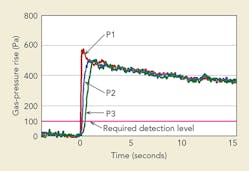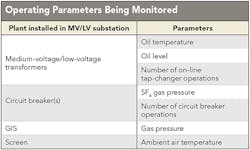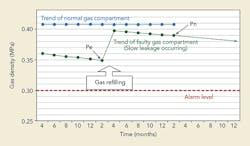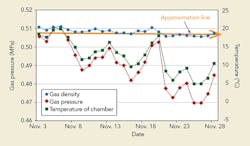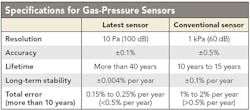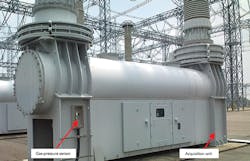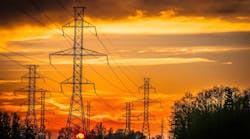Japan is addressing the low growth in demand for electrical energy, coupled with an increasing volume of aging equipment and a declining number of trained maintenance technicians. For electric utilities in Japan and around the world, it is becoming more challenging to maintain a high-quality, more reliable supply of power with fewer outages at a reduced cost.
The introduction of more efficient maintenance strategies together with the optimization of investment in equipment refurbishment is now considered a major issue that needs to be addressed. Activities introduced to provide solutions to this issue include acquiring maintenance information automatically using a monitoring system with advanced sensors, reducing plant outage times, monitoring the degradation of gas-insulated switchgear (GIS), improving the reliability of monitoring devices and reducing their costs.
Kansai Electric Power Co. (KANSAI) has a large number of medium-voltage/low-voltage (MV/LV) distribution substations located over an area of approximately 28,000 sq km (10,811 sq miles) that require regular maintenance. Therefore, an efficient maintenance programming system — aided by remote monitoring devices using sensor technology — has been an essential prerequisite for making maintenance activities more efficient.
Distribution Substation Monitoring
To support this effort, KANSAI installed GIS and equipped transformers in ground-mounted substations with a series of sensors, a converter unit and a server. Each item in the plant has sensors that acquire specific data required for maintenance programming. This monitoring system provides a continuous output of signals from each sensor, converts the signals into digital data and transmits the data to the substation server through a local area network cable. This enables the monitor terminals at KANSAI’s maintenance office to access the substation server through the existing Internet protocol (IP) network and download plant operational and performance data.
This relatively simple system of data acquisition has reduced the need for frequent manual substation inspection visits, eliminated human errors and reduced the revenue expenditure on this activity. Since implementation of monitoring, the time to record maintenance data on transformers and GIS has been reduced by 80%. It is particularly effective for GIS because of the large number of sensors, such as gas-pressure sensors installed in GIS, as well as for large-scale substations that have a large number of feeders controlled by GIS units.
In addition, the following benefits of the monitoring system are possible in the event of plant failures and interruptions to supply:
• Avoiding unnecessary dispatch of a maintenance crew to the substation because of a false alarm from the monitoring system
• Preparing materials needed for plant maintenance work at the substation
• Providing control center staff decision-making information on the need for and timing of load-transfer switching operations following receipt of a critical alarm from the distribution substation.
GIS Fault Location
Substations with primary voltages up to and including 154 kV generally supply a large number of outgoing feeders; therefore, a GIS failure can cause a wide-scale power outage. Fault location equipment is required for early detection of a GIS internal fault. Nevertheless, the fault current and pressure rise of the GIS are small for substations operating in this voltage range because of the resistor grounding system. This is why high-sensitivity and high-precision gas-pressure sensors are so necessary, as they can detect a slow gas leak some 20 years earlier than a conventional sensor. The slow-leak monitoring of aging GIS is regarded as one of the most valid asset management indicators.
The conventional fault location system consists of the gas-pressure sensor and a data-processing unit that receives fault signals from the bus bar protection following verification the ground fault current exceeds the preset detection level. This system was verified by the ground fault test to reach the required detection level. The gas-pressure sensors are installed directly on the GIS and bus bar chamber.
KANSAI conducted a pilot project to test the fault locator. The pilot proj ect confirmed that, following a ground fault, all the installed sensors reached the required detection sensitivity settings (100 Pa) required to detect the fault. By using this system, the required time for localizing the GIS fault location was reduced from several hours to less than 10 seconds.
GIS Degradation Monitoring
The SF6 gas-insulation system used in GIS must be subject to regular inspection and maintenance. Because SF6 gas is regarded as a contributor to global warming, the integrity of the insulation system is paramount. If any unexpected leak is observed, the leak must be stopped as soon as possible. Many O-rings are used in GIS, and more gas leaks are likely to occur on aged equipment as a result of O-ring deterioration.
Condition monitoring can be used to identify gas leaks on all GIS chambers, including the occurrence of slow gas leaks. Based on the life-cycle cost, an evaluation can be performed to determine whether the operation and maintenance costs for the remaining life of the equipment would exceed a renewal plan for the equipment. Part of KANSAI’s asset management strategy is to conduct on-site monitoring to determine gas leak trends on aged gas chambers, when possible. Refurbishment or replacement is then considered.
Case Study Confirmation
Gas-pressure sensors were installed on aging 84-kV GIS installed in an outdoor substation located near the sea. In this case, a small leak was confirmed before the gas-density switch operated and, following the gas refill, the monitoring terminal in the remote maintenance office confirmed the gas refill proved to be ineffective. Fine rust caused by the sea breeze, not identified in the course of periodic inspection, was detected and repaired. The gas-leak rate was only about 1% per year, so this gas leak was immediately identified from the remote maintenance site. This is in contrast to the expectation that the conventional gas-density switch would take 10 years to operate. This example proved high-sensitivity and high-precision gas-leak management is highly effective.
Similarly, data collection was performed on an aged 550-kV gas circuit breaker to determine the timescale for renewal. Data collected for one month indicated a decline in gas density, and as a result of detailed investigation, a slow gas leak was identified, confirming for KANSAI that monitoring this performance characteristic on aged GIS circuit breakers is one of the most valid asset management indicators.
Monitoring Improvement
For maintenance of GIS using the condition-based maintenance strategy, the sensors need to have high reliability to monitor GIS conditions accurately, so long-term trends can be identified using the same evaluation criteria (that is, by sensor).
The latest gas-pressure sensor developed in Japan provides stability and detection sensitivity that is more than 100 times more sensitive than the conventional sensors used to meet the detection sensitivity specified in International Electrotechnical Commission Standard 62271-303 (0.5% per year). Also, the lifetime and failure rate of these latest gas sensors are equivalent to those of GIS and gas circuit breakers, which means there is no need to repair or replace the sensor.
The temperature change characteristic is less than ±0.01% per degree Celsius and more than 10 times the stability compared with a conventional sensor. Therefore, stable measurement is possible under any temperature condition. The gas-pressure sensor is able to measure and be in service for more than 40 years without maintenance.
Cost Reduction and Results
The latest gas-pressure sensor has two functions: slow gas-leakage detection and grounding fault location. The system structure is simplified and cost per function is reduced by 50%. To reduce the initial cost, the operation and maintenance cost, the use of general-purpose parts in the acquisition unit and the substation server result in a reduction in the procurement cost.
When installing a new tool such as a monitoring system within a substation, it is important to train maintenance staff on the tool. The monitoring system installed by KANSAI was developed by the utility, with the exception of the sensor, so it is not entirely dependent on the equipment manufacturer. Therefore, in-house experts at KANSAI were able to deliver training to the maintenance staff, which benefited from being able to focus on learning a single system.
The maintenance data acquisition system reduced substation inspection activities and the initial cost by using an existing IP network. The gas-pressure sensor reduced the time required for localizing fault location to less than 10 seconds.
In addition, the pressure sensor with high-detection sensitivity of 0.5% per year or lower can detect slow gas leaks from aged equipment and can be used to develop the equipment renewals plan based on life cycle cost evaluation. The pressure sensor has a similar lifetime and fault rate as the GIS, and the life-cycle cost of the monitoring system is reduced because of the multifunction monitoring of gas leak and fault location.
Yoshinao Matsushita was manager of the substation group in the power system engineering center of Kansai Electric Power Co. He holds a MSEE degree from Kyoto University and is a member of the Institute of Electrical Engineers of Japan. And for the past six years, Matsushita has participated in CIGRE’s Study Committee B3 (substations).
Shinya Iwasaki is deputy manager of substation group in the power system engineering center of Kansai Electric Power Co. He holds a MSEE degree from Osaka University and is a member of the Institute of Electrical Engineers of Japan.
Ryota Tomokane is an engineer in the hydropower and substation group at Kansai Electric Power Co.’s head office. He holds a master’s degree in electrical and electronic engineering from Osaka Prefecture University and is a member of the Institute of Electrical Engineers of Japan.

